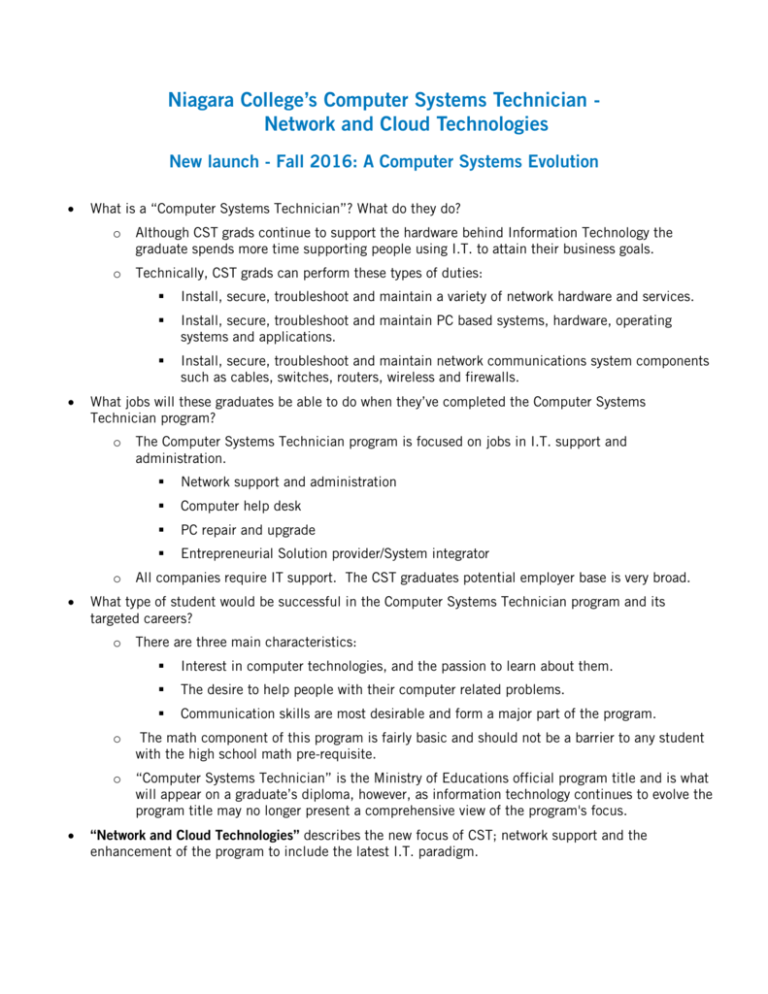Niagara College's Computer Systems Technician
advertisement

Niagara College’s Computer Systems Technician Network and Cloud Technologies New launch - Fall 2016: A Computer Systems Evolution • • What is a “Computer Systems Technician”? What do they do? o Although CST grads continue to support the hardware behind Information Technology the graduate spends more time supporting people using I.T. to attain their business goals. o Technically, CST grads can perform these types of duties: o Install, secure, troubleshoot and maintain PC based systems, hardware, operating systems and applications. Install, secure, troubleshoot and maintain network communications system components such as cables, switches, routers, wireless and firewalls. The Computer Systems Technician program is focused on jobs in I.T. support and administration. Network support and administration Computer help desk PC repair and upgrade Entrepreneurial Solution provider/System integrator All companies require IT support. The CST graduates potential employer base is very broad. What type of student would be successful in the Computer Systems Technician program and its targeted careers? o • Install, secure, troubleshoot and maintain a variety of network hardware and services. What jobs will these graduates be able to do when they’ve completed the Computer Systems Technician program? o • There are three main characteristics: Interest in computer technologies, and the passion to learn about them. The desire to help people with their computer related problems. Communication skills are most desirable and form a major part of the program. o The math component of this program is fairly basic and should not be a barrier to any student with the high school math pre-requisite. o “Computer Systems Technician” is the Ministry of Educations official program title and is what will appear on a graduate’s diploma, however, as information technology continues to evolve the program title may no longer present a comprehensive view of the program's focus. “Network and Cloud Technologies” describes the new focus of CST; network support and the enhancement of the program to include the latest I.T. paradigm. Cloud Computing • What changes have been made to CST? o Increased focus on Cloud technologies used in I.T.; such as hypervisors and virtual machines. o What are hypervisors and virtual machines? • A hypervisor is software that allows the concurrent operation of many operating systems on one physical PC or server. • The operating systems that are sharing the physical hardware are called virtual machines. Revised content to include: Server hardware and hypervisor support Router installation and support Wide Area Network protocols Public, private and hybrid cloud technologies • Public Cloud – companies that offer Cloud Computing services over the Internet such as Amazon and Google. • Private Cloud – using Cloud technologies within a business’s data center. An inhouse Cloud. • Hybrid Cloud – the interconnection of a Private Cloud and a Public Cloud Infrastructure as a Service (IaaS), Platform as a Service (PaaS) and Software as a Service (SaaS) • IaaS – the Cloud provider provides access to virtual machines running in the Cloud providers hardware environment on which a business runs its own operating systems and application software in the Cloud. • PaaS – the Cloud provider provides the physical network plus the server operating systems such as Windows Server or Linux. Generally used as a platform to develop custom applications for web delivery. • SaaS – the Cloud provider provides the physical network, plus the server operating systems, plus the application software such as database or productivity software. Cloud data storage technologies Keeping Cloud services available/accessible/protected • fault tolerance, business continuity, high availability Securing the Cloud Installing and supporting a Private Cloud 2







